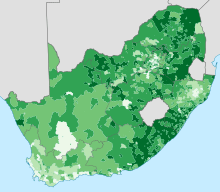Conservative Party (South Africa)
Conservative Party of South Africa Konserwatiewe Party van Suid-Afrika | |
|---|---|
.gif) | |
| Leader |
Andries Treurnicht 1982–1993 Ferdinand Hartzenberg 1993–2004 |
| Founded | 1982 |
| Dissolved | 2004 |
| Merged into | Freedom Front |
| Headquarters | Cape Town |
| Ideology |
Conservatism Separate Development Afrikaner nationalism Paleoconservatism White nationalism |
| Political position | Far-right |
| Website | |
| N/A | |
The Conservative Party of South Africa (Konserwatiewe Party van Suid-Afrika in Afrikaans) was a hard right party that wished to conserve many aspects of apartheid in the system's final decade. It formed the official opposition in the white-only House of Assembly in the last seven years of apartheid although it declined after apartheid before being merged with the Freedom Front in 2004.
Foundation and early support
It was formed in 1982 by 23 MPs from the ruling National Party who opposed Prime Minister PW Botha's reforms to apartheid and power sharing proposals, which they saw as a threat to white minority rule, and the racial segregation known as Separate Development. Led by Andries Treurnicht, a former Dutch Reformed Church minister popularly known as 'Doctor No'. The CP's English-language programme booklets from 1987-89 stated that the party was established "to continue the policy of self-determination after the [NP] government had exchanged self-determination" (something the CP described as an "infallible policy"), for power-sharing.[1][2] It drew support from white South Africans, mostly Boer/Afrikaners in the rural heartlands of South Africa.
Official opposition
It became the official opposition in the whites-only House of Assembly of South Africa in the elections of 6 May 1987, when it surpassed the liberal Progressive Federal Party, winning 550,000 votes. Donald Simpson, writing in the South African newspaper, The Star, went as far as to predict that the National Party would lose the next election and that the Conservative Party would become the new government of South Africa.[3]
In the local elections of 1987 the Conservative Party won 60 municipalities out of 110 in the Transvaal, and 1 out of 4 in the Orange Free State. The Conservative Party received 45% of the Afrikaner votes and 7.5% of the English-speaking votes. It won 50% of the Afrikaner vote in the Transvaal and Free State provinces in the 1989 general elections. It won 40% of the White popular vote in the Transvaal, and 45% in the Orange Free State provinces in the 1989 elections.
In the late 1980s, the party established links with the British conservative anti-communist pressure group, the Western Goals Institute[4] as well as the Conservative Monday Club, a supporter of white rule in South Africa.[5]
Opposition to negotiations to end apartheid
In the general election of 1989, the last before multi-racial elections, the party strengthened its vote to 31.52% of the white electorate and 41 seats in the House of Assembly.
The Conservative Party led the "no" campaign during the 1992 referendum, when white South Africans were asked to determine whether or not they supported the negotiated reforms started by the government. Apart from Treurnicht, the official Leader of the Opposition and Clive Derby-Lewis, the Shadow Finance Minister, the no side was supported by former President P W Botha, who denounced de Klerk's reforms as irresponsible and perilous to the stability of the country. The result was a defeat for the "no" side, when 68% of white voters voted "yes".
Clive Derby-Lewis was found guilty in 1993 (under the emergency legislation enacted by the House of Assembly) of involvement in the assassination of South African Communist Party leader Chris Hani. In 1997, party leader Ferdi Hartzenberg testified before the Truth and Reconciliation Commission that the assassination had been carried out on the party's behalf.[6]
Election results

| Election year | # of total votes | % of overall vote | # of seats won | Rank |
|---|---|---|---|---|
| 1987 | 574 502 |
26.6% |
22 |
2/5 |
| 1989 | 680,131 |
31.5% |
39 |
2/4 |
Post apartheid decline and dissolution
Its support rapidly declined after majority rule in 1994. The decision not to participate in the first multi-racial parliamentary elections in 1994 resulted in much of its support base defecting to the newly formed Freedom Front which had been joined by one of its MPs Pieter Mulder. In the 1995-1996 municipal elections, the CP won 57 seats (out of 11 368) and a mere fraction of the votes compared to the FF and the NP.
In 2003, the Conservative Party joined forces with another party of similar views, the Freedom Front, now led by Mulder, to form the Freedom Front Plus. As well as Mulder two other former Conservative Party MPs, Corné Mulder and Pieter Groenewald, serve as Freedom Front Plus MPs.
A new political party that was founded from old members of the Conservative Party on 16 April 2016. With similar beliefs, policies and logo, namely the National Conservative Party of South Africa.
References
- ↑ The Conservative Party has the Solution, English language party booklet, n/d but early 1989
- ↑ The Conservative Party of South Africa - Programme of Principles and Policy, English language booklet, 1988
- ↑ The Star, 24 May 1987
- ↑ Who hosted at least two visits to London by Treurnicht and other delegates. On 5 June 1989 Treurnicht was accompanied by Clive Derby-Lewis, Member of Parliament for Krugersdorp, and Carl Werth, the party's organizer in Natal, on a ten-day tour of European capitals.
- ↑ Which hosted a black-tie banquet at the Charing Cross Hotel in London for Treurnicht and his entourage.
- ↑ "Right-wing party behind S.A. killing". 4 December 1997 – via bbc.co.uk.